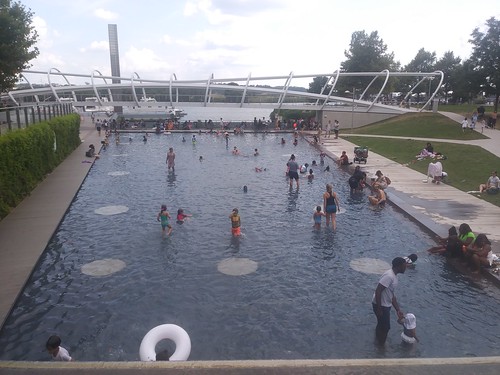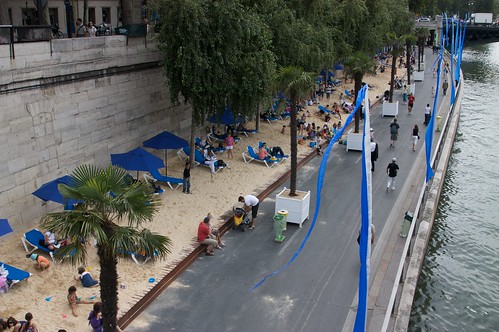Engaging citizens in DC's rivers and waterfronts as a way to drive improvements in water quality
With the aim of getting more people engaged and concerned and active around the idea of fishable and swimmable rivers in DC, which means the Potomac and Anacostia Rivers ("From Sewage Dump To Beach: Washington’s Rivers May Be Safe To Swim Within 5 Years," WAMU-FM/NPR)...
When I was looking at how many people were in the wading pool at Yards Park on the Southeast Waterfront yesterday ...

I couldn't help but think that they should have planned this space to have a "Paris Plages" sandy beach on one side.

And there are various efforts in places where pools are inserted into rivers that otherwise have poor water quality. Like the Badeshiff pool in Berlin's River Spree. We need such pools in both the Anacostia and Potomac Rivers.

New York City Pirates jet ski group near the Manhattan Bridge in June. Photo by Johnny Milano for the New York Times.
The New York Times has a piece, "With Jet Ski Invasion, the Wild Ones Take to the Rivers," about an annual event where jet ski enthusiasts take to the city's rivers as a kind of display of defiance, making the point that the rivers are open even to jet skis, which otherwise are disdained by boaters and public officials.
My debate a couple years back with the leaders of the Anacostia River Conservancy is that despite the fact that much of the land along the river is owned by the federal government, they needed to take some ownership of the river, even if more virtual, through various activities. This could be one.
 Baltimore has the kinetic sculpture water race...
Baltimore has the kinetic sculpture water race...Baltimore's Waterfront Partnership is a great example of that.
It functions as both a business improvement district managing commercial district public space along the city's waterfront but simultaneously serves as a kind of advocacy group for the Inner Harbor and the city's waterfronts, albeit the organization is strongly embedded within the Growth Machine.
(In DC-Maryland, the separate Anacostia Watershed Society is definitely much more of an advocacy group. ARC has the Growth Machine part down, but not the civic engagement element.)
-- "Podcast: What Baltimore's waterfront could look like in five years," Baltimore Business Journal, 2018
-- "Waterfront Partnership expands services to Fells Point," BBJ, 2018
Especially because east of the 11th Street Bridge, the water isn't that deep. It's not very good for boating. You can't sail really. Jet skis could work. Waterskiing probably not. Etc.
I also wrote a long paper about how land on the RFK Campus abutting the river could be used for the creation of a public beach and integration of various water-related activities, even saunas in winter. For the most part, the plan to redo the RFK Campus ignores the opportunity to engage with the river.
=====
Also see:
-- "Revisiting stories: DC's waterfront," 2018
-- "Why not a summer "water taxi" service to Roosevelt Island in the Potomac River," 2018
-- "DC puts forward legislation to create Waterways Commission and Authority," 2019
Labels: civic engagement, community organizing, rivers and waterfronts, urban design/placemaking




0 Comments:
Post a Comment
<< Home